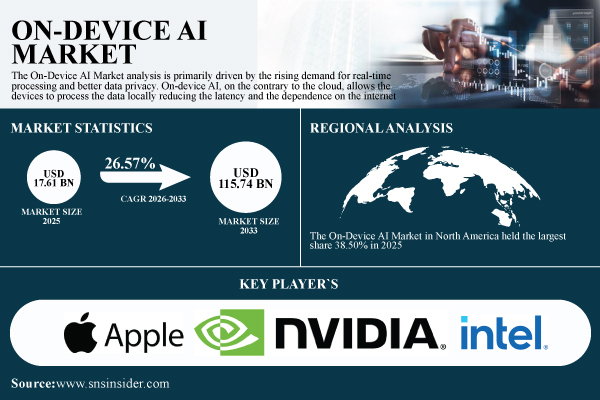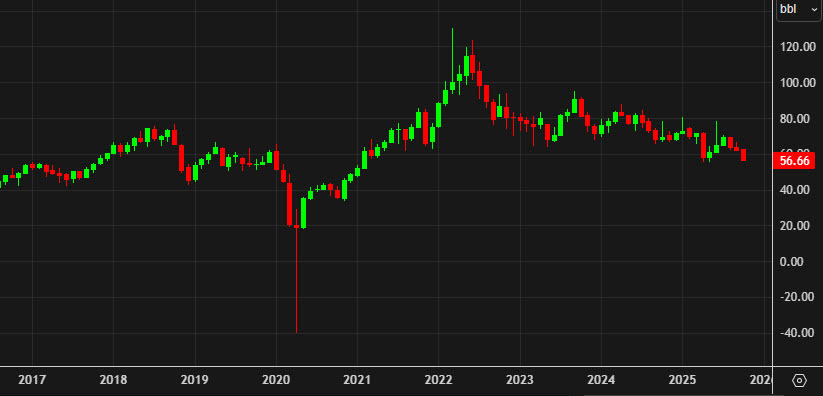The global On-Device AI Market is projected to grow significantly, reaching an estimated value of USD 115.74 billion by 2033. This expansion is driven by increasing demand for real-time processing capabilities and enhanced data privacy, according to a report by SNS Insider. The market, valued at USD 17.61 billion in 2025, is expected to achieve a compound annual growth rate (CAGR) of 26.57% from 2026 to 2033.
The shift from cloud-based solutions to on-device AI technology is a key factor in this growth. On-device AI allows devices to process data locally, reducing latency and reliance on internet connectivity. This is particularly crucial for applications in sectors such as wearables, smartphones, and automotive systems.
Market Insights and Growth Drivers
In the United States, the On-Device AI Market is anticipated to increase from USD 4.88 billion in 2025 to USD 31.59 billion by 2033, marking a CAGR of 26.32%. The need for improved data privacy and real-time processing is fuelling this increase. As edge computing technology advances, it allows for efficient local data processing, which is significantly less dependent on cloud services.
The report highlights a segmentation analysis of the market. In 2025, the hardware segment is expected to dominate with a market share of 60.40%. This segment’s strength is attributed to the widespread adoption of various AI-enabled processors, sensors, and chipsets found in smartphones, wearables, and industrial devices. By contrast, the software segment is anticipated to be the fastest-growing, with a CAGR of 31.04%, driven by the demand for smart algorithms and AI frameworks that operate effectively on edge hardware.
Segment Performance and Future Projections
When examining specific device categories, smartphones and tablets are projected to hold the largest market share of 56.70% in 2025, thanks to the integration of on-device AI functions such as facial recognition and augmented reality. Wearables are identified as the fastest-growing segment, with a CAGR of 25.24%, propelled by the increasing adoption of AI-powered smartwatches and fitness monitoring devices.
In terms of technology, machine learning is expected to lead the market with a share of 48.20% in 2025, while natural language processing (NLP) is set to experience the fastest growth at a CAGR of 26.40%. The rising use of voice assistants and chatbots is driving this trend, making NLP a vital technology in the on-device AI landscape.
The consumer electronics sector currently commands the largest share of the market at 41.06%, reflecting the rapid adoption of AI-integrated devices. The automotive sector, however, is the fastest-growing vertical, expanding at a CAGR of 25.30%. This growth is largely attributed to advancements in on-device AI applications within advanced driver-assistance systems (ADAS) and autonomous driving technologies.
Regional analysis indicates that North America held the largest market share of 38.50% in 2025, driven by its early adoption of advanced AI technologies and robust research and development infrastructure. Meanwhile, the Asia Pacific region is poised for rapid growth, projected to expand at a CAGR of 27.83% due to increasing adoption of AI-powered devices across various industries.
Recent developments in the sector include the launch of Google LLC’s Gemini 2.0 Flash in February 2025, an on-device AI model offering enhanced capabilities. Additionally, Qualcomm Technologies, Inc. unveiled the Snapdragon 8 Elite Gen 5 System on Chip (SoC) in September 2025, which is designed to significantly boost on-device AI capabilities in Android devices.
The on-device AI market is poised for transformative growth, driven by technological advancements and increasing consumer demand for privacy and efficiency. As companies continue to innovate, the landscape is likely to evolve rapidly, presenting significant opportunities for stakeholders across various sectors.






